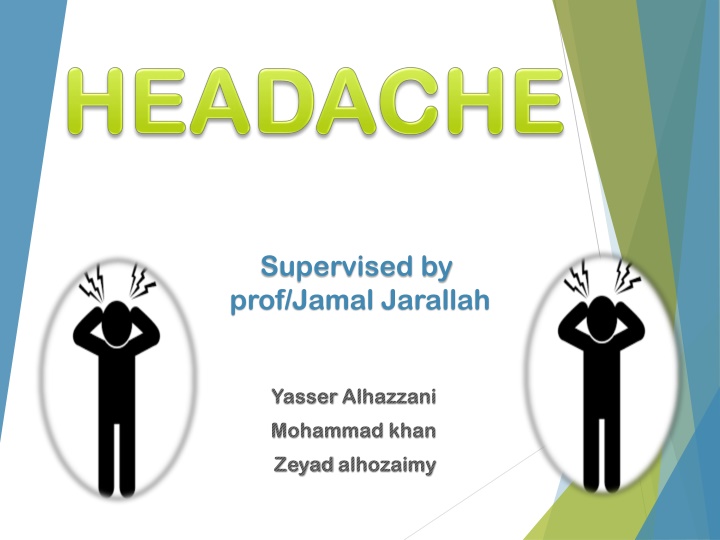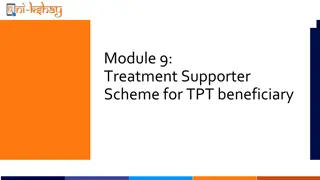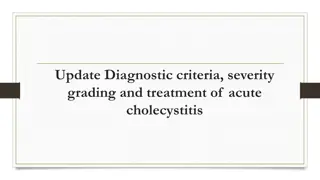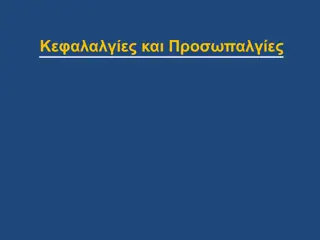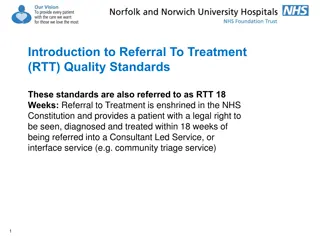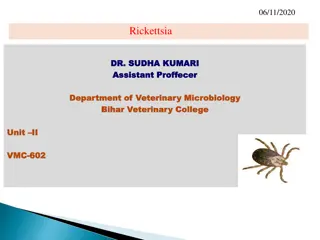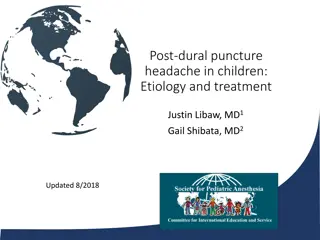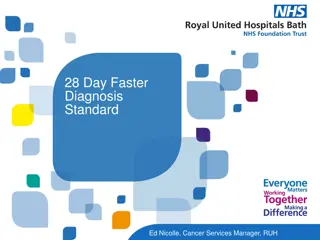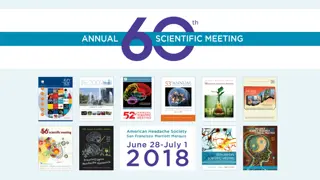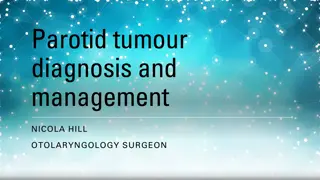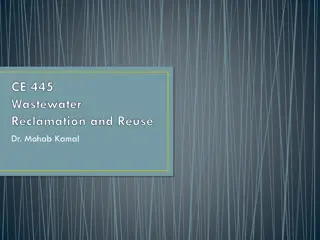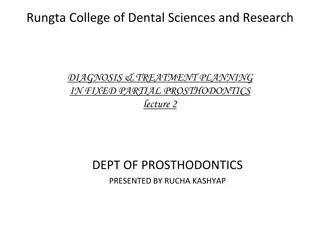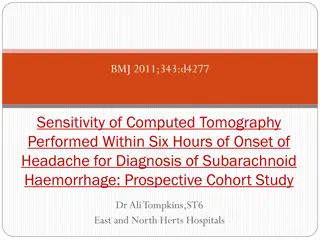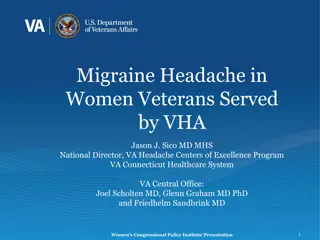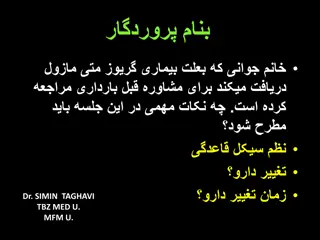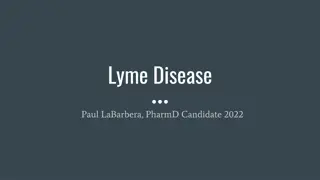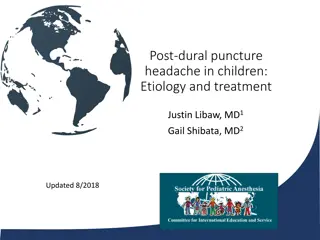Headache Management: Types, Diagnosis, and Treatment
Defining common types of headaches, such as migraine, tension headache, and cluster headache, along with an approach to patient assessment, red flags, and appropriate investigations. Understand the role of primary care physicians, drug treatments, and when to refer to specialists. Pre-test scenarios to test your knowledge on headache cases.
Download Presentation

Please find below an Image/Link to download the presentation.
The content on the website is provided AS IS for your information and personal use only. It may not be sold, licensed, or shared on other websites without obtaining consent from the author.If you encounter any issues during the download, it is possible that the publisher has removed the file from their server.
You are allowed to download the files provided on this website for personal or commercial use, subject to the condition that they are used lawfully. All files are the property of their respective owners.
The content on the website is provided AS IS for your information and personal use only. It may not be sold, licensed, or shared on other websites without obtaining consent from the author.
E N D
Presentation Transcript
Supervised by prof/Jamal Jarallah Yasser Yasser Alhazzani Alhazzani Mohammad khan Mohammad khan Zeyad Zeyad alhozaimy alhozaimy
Objective Definition and epidemiology Common types of headache Migraine, Tension headache, Cluster headache How to approach a patient with headache Red Flags and indications for further investigations like CT brain, MRI Brief comment on Migraine, Tension Headache, Cluster headache, benign intracranial tension, temporal arteritis, space occupying headaches. What is the role of primary health care physician in management Drug treatment and Prophylaxis What investigations could be requested if needed When to refer to specialist
1-A 30-year-old lady, presented with C/O headache, unilateral, pulsating in nature, severe, lasts for few hours and increases by daily routine physical activities. Past H/O having similar attacks on and off past few years. Not known to have any other problem. What is the most likely diagnosis? What is the most likely diagnosis? A) Cluster headache. B) Migraine. C) Subarachnoid hemorrhage. D) Tension headache.
2-A 35-years-old male comes to your office with a 6-month history of recurrent daily headaches, usually in the late afternoon. The headaches are described by the patient as compressing in nature. The headaches are not associated with nausea, vomiting, or malaise. The patient describe some dizziness and light headedness with these headaches. On examination: unremarkable What is the likely type of headache in this patient? What is the likely type of headache in this patient? A) Chronic daily headache: tension type. B) Episodic tension-type headache. C) Migraine without aurea. D) Cluster headache.
3-A 19-years-old woman with a BMI of 34, presents to her physician with a 6-month history of intermittent headaches associated with visual blurring. She also gives history of vague menstrual irregularities. Fundoscopy shows papilloedema. Routine investigations including ESR, CT head scan and lumbar puncture are normal. The most likely diagnosis is: The most likely diagnosis is: A) Benign intracranial hypertension. B) Giant cell arteritis. c) Subdural haemorrhage. D) Tension headache.
4 4- -The first The first- -line treatments of Cluster Headache is: line treatments of Cluster Headache is: A) Sumatriptan injections B) Zolmitriptan nasal spray c) Oxygen D) All of the above.
Definition and epidemiology Definition and epidemiology
Definition: Headache Headache : is pain anywhere in the region of the head or neck. It can be a symptom of a number of different conditions of the head and neck.
Epidemiology: the most most prevalent prevalent symptoms seen in general. The prevalence of migraine and tension headache in KSA is 12.1% Tension Headache > Migraine. Equal in Tension Headache Tension Headache. Female: Male 2-3:1 in Migraine. Female: Male1:10 in Cluster Headache
Common types of headache Common types of headache Migraine, Tension headache, Cluster headache headache, Cluster headache Migraine, Tension
Classification: Primary: Primary: Secondary: Secondary: Tension-type headache (TTH) Medication overuse 1. 1. Cervicogenic headache 2. Migraine 2. Infection 3. Cluster headache 3. Vascular 4. Raised intracranial pressure. 5. Trauma 6.
How to approach a patient with How to approach a patient with headache headache https://youtu.be/qRqYIHpem9M https://youtu.be/_6_OzASXgQs
Approach to a patient with headache: History: History: SOCRATES (for HEADACHE) (site, onset, character, radiation, associated symptoms, time, aggrevating & releiving, severity) Past medical (history of head trauma, anurysm..) Family history (+ve of migrain) Drug history (overdose) Social history (stress)
Examination: A- Vital signs. b. General appearance. c. General examination, with a focus on the head and neck, Palpate (skull base, TMJs, temporal arteries, upper cervical facets, pericranial muscles, paranasal sinuses). d. Full neurological examination.
Investigations: When headache does not clearly fit into one of When headache does not clearly fit into one of the recognized primary headache or if there the recognized primary headache or if there are atypical symptoms. are atypical symptoms. Non Non- -Contrast CT Scan: Contrast CT Scan: Decreased level of consciousness Decreased level of consciousness one sided weakness one sided weakness pupil size difference pupil size difference
Red Flags in patient with Red Flags in patient with headache headache
:Red Flag Worsening headache with fever. Sudden-onset headache reaching maximum intensity within 5 minutes. New-onset neurological deficit. New-onset cognitive dysfunction. Change in personality. Impaired level of consciousness. Recent (typically within the past 3 months) head trauma.
Cont: Headache triggered by cough. Headache triggered by exercise. Orthostatic headache (headache that changes with posture). Symptoms suggestive of Giant cell artritis.
When to refer to specialist When to refer to specialist headache.jpg
Who needs a referral? compromised immunity, caused for example by HIV or immunosuppressive drugs. age under 20 years and a history of malignancy a history of malignancy known to metastasise to the brain vomiting without other obvious cause.
Brief comment on Migraine, Tension Headache, Brief comment on Migraine, Tension Headache, Cluster headache, benign intracranial tension, Cluster headache, benign intracranial tension, temporal arteritis, space occupying headaches. temporal arteritis, space occupying headaches.
Migraine: Migraine is a chronic neurological disorder characterized by recurrent moderate to severe unilateral, throbbing headache Associated with nausea, vomiting, or photo- and phonophobia. It usually lasts 4 to 72 hours.
Phases: 1. The prodrome, which occurs hours or days before the headache 2. The aura, which immediately precedes the headache 3. The pain phase, also known as headache phase 4. The postdrome, the effects experienced following the end of a migraine attack
Management: prevent the trigger factors: Stress factors: Food factors: caffeine, chocolate, meat, alcohol, aged cheese Sleep factors: Environmental factors: Exposure to flashing, bright or fluorescent lights, Weather changes \ Pollution. Drugs: HRT, Antibiotics, SSRIs, OCP, Antihypertensive, Vasodilators, Benzodizepine withdrawal and Nitrates.
Con: Acute Treatment: oral triptan and an NSAID. an oral triptan and paracetamol. For people aged 12 17 years consider a nasal triptan in preference to an oral triptan. DO NOT give an opioids.
Cont: Chronic Treatment: 1stline : Beta blocker or TCA before bed 2ndline: Topiramate (antiepileptic) 3rdline: Gabapentin (antiepileptic)
Tension Type Headache (TTH): Typically bilateral, non-throbbing, and described with such words as pressure, squeezing, or tightness. This is usually due to stress, neck strain. TTH is the most common primary headache disorder. chronic TTH affects 1-3% of adults.
Causes: head to be held in one position for a long time without moving. Other triggers Alcohol use. Caffeine (too much or withdrawal) Common cold, sinusitis. Dental problems Eye strain Excessive smoking Fatigue or overexertion triggers of tension headaches include: 1. 2. 3. 4. 5. 6. 7.
Management: Acute aspirin, paracetamol or an NSAID.
Cluster Headache (CT): Characterized by excruciating peri- orbital pain.. Unilateral . Pain may be so sever , the patient may even become suicidal. Accompanied by cranial autonomic symptoms such as a rhinorrhea, reddening of the eye, and lacrimation, all ipsilateral to the pain. It typically lasts 30-90 minutes
Management: Acute clusterattacks: are best treated with high-flow oxygen and parenteral Sumatriptan.
Cont: Prophylaxis: Of all headache types, cluster headache are the most responsive to Prophylactic treatment . Should seek for specialist: Verapamil. Drug of choice during pregnancy.
Benign intracranial tension: is a neurological disorder that is characterized by increased intracranial pressure (pressure around the brain) in the absence of a tumor or other diseases.
Cont: Symptoms are headache, pulsatile tinnitus, double vision, nausea and vomiting. It may lead to swelling of the optic disc in the eye, which can progress to vision loss.
Cont: Diagnosed by Diagnosed by CT scan and Lumbar Puncture. Treated by Treated by acetazolamide acetazolamide or surgical. surgical.
Temporal Arteritis: Form of vasculitis. is an inflammatory disease of blood vessels most commonly involving large and medium arteries of the head. Headache, bruit, fever and jaw claudication. Biopsy is the gold standard to diagnosis. treated by Corticosteroids.
Pattern: Pattern: recurrent attack : 4 hours to 3 days 1-2 times / month Migraine Tension Headache hours to a few days a) Episodic TH : 1-14 days /month b) Chronic TH : 15 days /month (daily) Cluster Headache short-lasting attacks : 15-180 minutes 1 time daily in 6-12 weeks
Character: Character: Unilateral pulsating moderate to severe Migraine Generalized and radiate to the neck Pressure or tightness mild to moderate TH unilateral around the eye very severe CH
Associated symptoms: Associated symptoms: Migraine nausea and/or vomiting photo- and/or phonophobia TTH mild nausea, but no vomiting in chronic TH only CH red and watering eye Running or blocked nostril Ptosis
What is the role of primary health care What is the role of primary health care physician in management physician in management Drug treatment and Prophylaxis and Prophylaxis Drug treatment
Role of Primary Health Care Physician: To arrange specific consultations for headache. To institute a system of detailed history taking, patient education at the outset of the consultation. To institute a process of individualized algorithm. Assessing the impact on the patient's daily life is a key aspect management. management that is patient, using for each a new of diagnosis and
Cont: To prescribe only treatments that have objective evidence of favorable efficacy and tolerability. To utilize prospective follow-up procedures to monitor the success of treatment. To organize a team approach to headache management in primary care
1-A 30-year-old lady, presented with C/O headache, unilateral, pulsating in nature, severe, lasts for few hours and increases by daily routine physical activities. Past H/O having similar attacks on and off past few years. Not known to have any other problem. What is the most likely diagnosis? What is the most likely diagnosis? A) Cluster headache. B) Migraine. C) Subarachnoid hemorrhage. D) Tension headache. B B
2-A 35-years-old male comes to your office with a 6-month history of recurrent daily headaches, usually in the late afternoon. The headaches are described by the patient as compressing in nature. The headaches are not associated with nausea, vomiting, or malaise. The patient describe some dizziness and light headedness with these headaches. On examination: unremarkable What is the likely type of headache in this patient? What is the likely type of headache in this patient? A) Chronic daily headache: tension type. B) Episodic tension-type headache. C) Migraine without aurea. D) Cluster headache. A A
3-A 19-years-old woman with a BMI of 34, presents to her physician with a 6-month history of intermittent headaches associated with visual blurring. She also gives history of vague menstrual irregularities. Fundoscopy shows papilloedema. Routine investigations including ESR, CT head scan and lumbar puncture are normal. The most likely diagnosis is: The most likely diagnosis is: A) Benign intracranial hypertension. B) Giant cell arteritis. c) Subdural haemorrhage. D) Tension headache. A A
